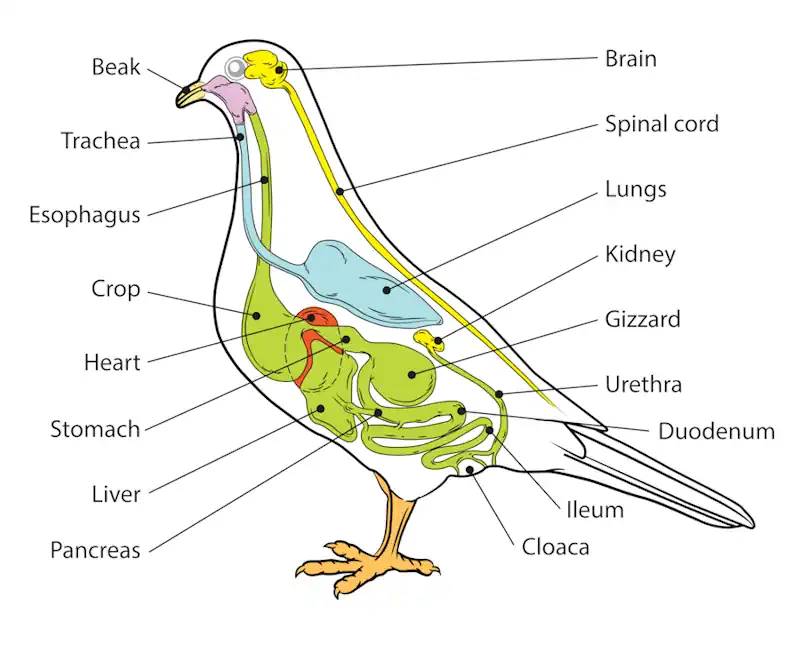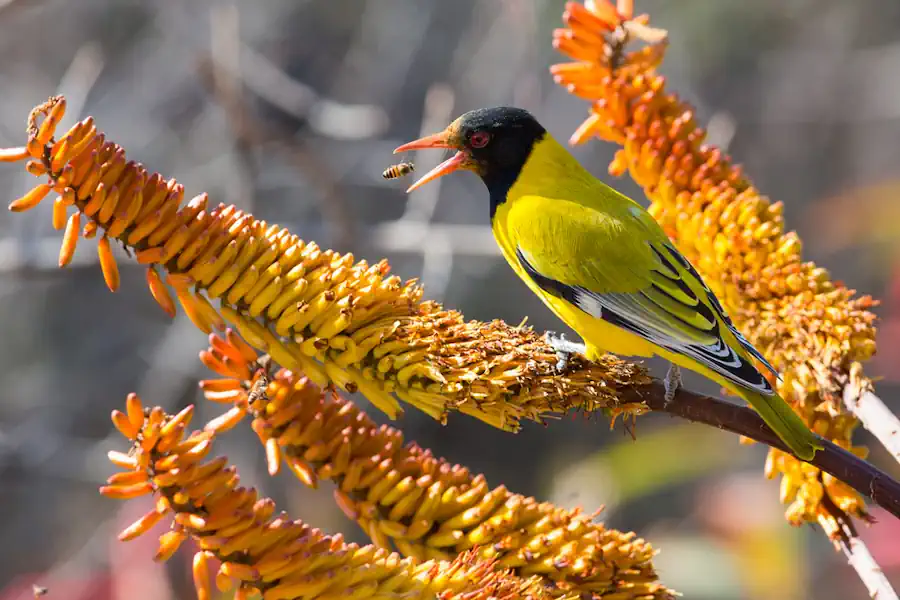Did you know that some birds can break down their food in less than two hours? This is incredibly fast compared to humans, who might need more than a day to do the same.

Birds have evolved to have really efficient digestive systems so they can get the most nutrition in very little time, which is vital for them to survive. They have special body parts that help them eat and digest food quickly, like their beaks that tear up the food and a powerful part of their stomach, called the gizzard, that grinds the food without needing teeth. Even though food moves quickly through a bird’s body, they still manage to get all the nutrients they need.
This quick digestion is important because it helps birds stay light enough to fly and gives them the energy they need without having to carry around heavy, undigested food.
When we look at how birds digest their food, we can learn a lot about how they live and behave. For example, birds that eat on the go, like hummingbirds, have even faster digestion to match their high-energy lifestyle. This shows just how much a bird’s body is perfectly suited to its way of life.
Avian Digestive Adaptations
Birds have a special way of eating and digesting their food to help them stay strong and healthy. Their beaks are shaped to match the kind of food they eat, which helps them break it down into smaller pieces. Since birds don’t have teeth, they have a part in their throat, called a crop, that holds the food for a while, making it softer. After that, the food goes to a part of the stomach, called the proventriculus, where it starts to get digested with enzymes. Then, the food moves to the gizzard, which is like a strong little muscle that crushes the food even more. Birds often eat small stones that stay in the gizzard to help mash up their food.
This special eating system helps birds get all the energy and protein they need. For example, a hawk has a sharp, hooked beak to tear meat, while a duck has a flatter beak to scoop up plants and small creatures from the water. This shows how birds have changed over time to live and eat in different ways. By understanding their unique digestion, we can see how amazing birds are at adapting to their environments.
Beak and Esophagus Functions
Birds have special ways of eating that help them get the most out of their food. Their beaks and throats are key parts of this. Let’s look at what each part does.
- Beak: Birds use their beaks to break food into small bits. This can mean tearing, cracking, or picking, depending on the bird’s diet and beak shape. For example, a hawk’s sharp beak rips meat, while a finch’s strong beak cracks seeds.
- Crop: This is a pouch in a bird’s throat where food is stored for a bit. It’s like a temporary food holder that lets birds eat a lot quickly and then digest it slowly. Imagine a pigeon in a park gobbling up seeds; it’s using its crop to store those seeds.
- Esophagus to Crop: The esophagus is the tube that carries food from the mouth to the crop or to the stomach if there’s no crop. It works like a conveyor belt, moving the food along.
Understanding these parts helps us see why birds are such efficient eaters. For instance, if you’re feeding birds, you’d choose seeds for a finch or meat for a hawk, based on their beak types. And knowing about the crop, you wouldn’t worry if a bird stops eating after a while—it’s just digesting what’s in its crop.
These insights into bird digestion show how amazing these creatures are and how we can help them thrive.
Stomach Structure Efficiency

Birds don’t have teeth, but they have a really smart stomach design that helps them digest food well. Their stomach has two parts.
The first part is the proventriculus, where food gets broken down with chemicals, kind of like how our stomachs work.
The second part is the gizzard, which is like a strong muscle that crushes food. Since birds can’t chew, they eat small rocks that go into the gizzard to help smash their food into tiny pieces. This is super important because birds need to get energy from their food quickly to keep their muscles strong for flying.
Also, their guts, like the large intestine, are good at pulling out all the energy from the food they eat. This way, by the time the food gets to the end of the digestive system, the bird’s body has taken in all the good stuff it needs.
Intestinal Nutrient Uptake
After food is ground up in the gizzard, it moves to a bird’s intestines. Here, the bird’s body absorbs the nutrients it needs to stay alive and to fly. Birds are good at getting nutrients from small amounts of food, so they don’t have to look for food too often.
- Villi and Microvilli: These are like tiny fingers lining the intestines that make the space bigger so the bird can absorb as many nutrients as possible.
- Selective Permeability: The walls of the intestines are smart. They let the good nutrients in and keep the bad stuff out.
- Counter-Current Exchange: This is a clever system that makes it easier for the bird to absorb nutrients by using a special flow.
- Enzymatic Breakdown: Different enzymes act like scissors, cutting up complex food molecules so the bird can absorb them.
- Symbiotic Relationships: The good bacteria in the bird’s gut help make extra nutrients, which makes digestion even better.
Birds have a smart digestive system. For example, the villi and microvilli in their intestines are like having a larger sponge to soak up water. This design helps birds get the most out of their food. When harmful substances come along, the intestines act like a bouncer at a club, only letting in the VIP nutrients.
Imagine a busy highway where cars are the nutrients. The counter-current exchange is like a special express lane that gets the nutrients where they need to go faster. The enzymes in the bird’s intestines work like a team of chefs who specialize in chopping up different ingredients. And the bird’s gut bacteria are like helpful neighbors who bring over extra food when it’s needed.
Liver and Pancreas Roles

In birds, the liver and pancreas are key for digestion. The liver makes bile, which breaks down fats, and the pancreas creates enzymes that help digest sugars, proteins, and fats. This helps birds get all the nutrients they need from their food, which is vital because they have fast metabolisms to support activities like flying.
Scott McWilliams from the University of Rhode Island points out that these organs are crucial for birds because they meet the high energy needs required for flying. The liver cleans the blood and helps with fat digestion, while the pancreas helps keep blood sugar levels steady. This helps birds stay energetic and healthy.
Metabolic Rate and Energy Conservation
Birds lead active lives and need a fast metabolic rate to support essential activities like flying for long periods and laying eggs. They have a digestive system that works quickly and efficiently to make sure they get the nutrients they need from their food. It’s important to understand how birds use energy and save it when caring for them or planning how to protect them.
- Body Size: The size of a bird affects how much energy it uses every day. Larger birds generally need more energy.
- Migration: Birds that migrate make physical changes to use less energy when they travel long distances.
- Research by McWilliams: Scott McWilliams at the University of California has found that what birds eat is key to how they manage their energy.
- Science Foundation Studies: Research funded by organizations like the Science Foundation shows that birds must balance the energy they eat with the energy they use.
- Saving Energy: Birds have some smart ways to save energy. They look for food in a way that doesn’t waste energy and are really good at getting nutrients out of their food.
Final Thoughts
Birds have an amazing way of digesting their food that saves energy and is very efficient. They use their beaks to break down their food, and they have a special part of their stomach called the crop that stores food. Then, the gizzard, which is like a strong muscle, works with small stones that the bird has eaten to crush their food into tiny pieces. This makes it easier to digest.
Their stomach also has an area called the proventriculus where digestive juices start to break down the food even more. After that, the food moves through the intestines, where the body takes in all the good nutrients it needs. The liver and pancreas play a big role too, helping to manage the bird’s metabolism, which is how their body uses energy.
This whole process shows how well birds have adapted to their environment over time. They need less energy to stay alive because their bodies are so good at digesting food. This is especially important because birds often have to fly long distances and need all the energy they can get.
For example, when a hummingbird eats nectar, it uses its tongue which works like a tiny pump. The nectar gets quickly turned into energy that the hummingbird can use to keep flapping its wings really fast. This is just one example of how birds are built to survive in the wild.
